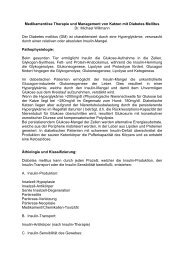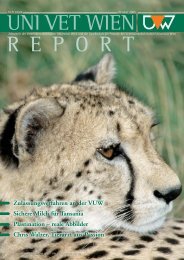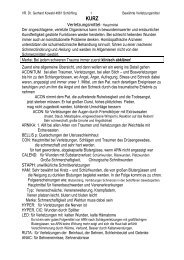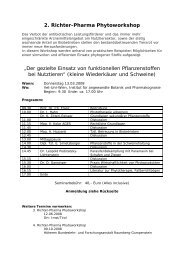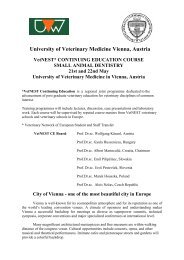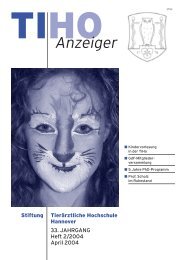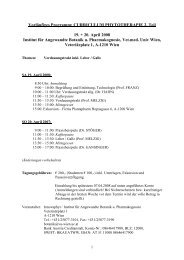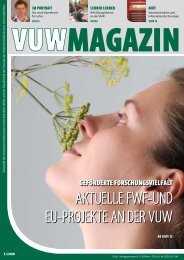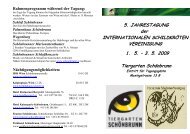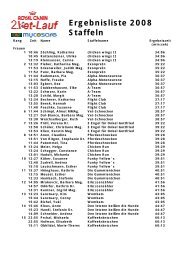<strong>Turtle</strong> <strong>and</strong> <strong>Tortoise</strong> <strong>Newsletter</strong>, Issue 3Preliminary Observations of a Large <strong>Turtle</strong> Farm in Hainan Province,People’s Republic of ChinaHAITAO SHI 1 AND JAMES FORD PARHAM 21Dept. of Biology, Hainan Normal Univ., Hainan 571158, People’s Republic of China2Univ. of California Museum of Paleontology, Valley Life Sciences Building, Univ. of California, Berkeley, CA 94720 USAMost of the 90 freshwater turtles <strong>and</strong> tortoise species ofAsia are threatened with extinction (Altherr <strong>and</strong> Freyer,2000; van Dijk et al., 2000). While there are many reasonsfor this decline, the single overriding cause is a massiveincrease in dem<strong>and</strong> for turtles in China generated by theunfortunate <strong>com</strong>bination of ancient tradition <strong>and</strong> newfound wealth (Behler, 1997). The intense harvesting ofwild turtles is fueled by a price for wild-caught Cuoratrifasciata that can exceed $1000 US/kg. The high valuehas earned C. trifasciata the <strong>com</strong>mon name of “cointurtle”. Other wild-caught turtles can <strong>com</strong>m<strong>and</strong> a price of$5 to $60 US/kg. In a country, such as Vietnam, where theaverage annual in<strong>com</strong>e is approximately $200 US, this issufficient to motivate intensive collecting effort.The massive dem<strong>and</strong> for <strong>and</strong> high prices attributed toturtles have also spurred the development of captivebreeding facilities. As the dem<strong>and</strong> for turtles increasesinversely to their diminishing numbers in the wild, thenumber of turtle farms grows quietly. Although some dataon the softshell industry exists (see Chen et al., 2000), dataon the farming of hard-shelled chelonians are <strong>com</strong>pletelylacking. This is despite the fact that as far back as 1992,Zhou <strong>and</strong> Zhou claimed that C. trifasciata was being bred“everywhere”. Furthermore, it is unclear whether thepractice of farming turtles is beneficial or deleterious to thefuture of Asia’s wild turtles. Van Dijk (2000) suggests aconstant supply of farm-reared turtles might reduce thedem<strong>and</strong> for wild turtles or, alternatively, create a climate inwhich wild turtles are even more valued by connoisseurs(the current case for Pelodiscus sinensis).In light of the burgeoning business of breeding turtles,especially Cuora trifasciata, it is imperative that weunderst<strong>and</strong> the size, scope, <strong>and</strong> practices of Chinese turtlefarms. The practices employed by the turtle farms, althoughprimitive <strong>com</strong>pared to st<strong>and</strong>ards of most zoos, might provideuseful information for captive breeding. The authors(primarily through the efforts of HS) have been able to enter<strong>and</strong> survey a large breeding facility in Tunchang, HainanProvince P.R.C.. Haitao Shi has visited the Tunchang turtlefarm seven times, one time with JFP. Our preliminaryobservations suggest that the number of captive rearedturtles in Asia has been greatly underestimated.The Tunchang turtle farmThe turtle farm in Tunchang was first established in1983 based on dozens of Cuora trifasciata, Mauremysmutica, <strong>and</strong> Ocadia sinensis collected from the field inHainan as well as animals from a previously establishedfarm in Guangdong. Today, the owner of the turtle farmclaims to have more than 50 species of turtles <strong>and</strong> 50,000individuals (30,000 of which are Pelodiscus sinensis) in an4eight hectare aquatic, outdoor enclosure (Fig. 1) <strong>and</strong>dozens of breeding pools in an indoor annex (Fig. 2a). Boththe outdoor enclosure <strong>and</strong> indoor annex are under closesupervision <strong>and</strong> guarded by about a dozen ferocious dogs(personal observation).In the outdoor enclosure, the nesting sites are restrictedto a raised dry area covered by a small cement building. Inthe indoor annex, small, cement breeding “ponds” areconnected to s<strong>and</strong>-filled nesting rooms through a series ofcement planks. Eggs are vigilantly harvested from theprovided nesting areas, placed in a separate indoorhatching area, <strong>and</strong> incubated at the ambient temperature.Hatchlings are raised in plastic tubs (Fig. 2b). At roughly 8-12 cm CL, they are placed into raising ponds (Fig. 3). At notime are the turtles from the indoor annex exposed tonatural light or even special lamps. In fact, most are kept innear darkness. The turtles are reared on a diet of fresh food(market fish <strong>and</strong> shrimp) <strong>and</strong> “coin turtle” br<strong>and</strong><strong>com</strong>mercial turtle food. We are told that the valuable C.trifasciata are given a higher quality diet than M. mutica(i.e., less <strong>com</strong>mercial food <strong>and</strong> more fresh food). The turtlesin the indoor raising ponds are raised to a sufficient sellingsize or eventually placed in a breeding pond. Most of theindoor breeding ponds are dominated by one species;however, all but the smallest C. trifasciata breeding ponds(e.g., Fig. 2) have multiple species. One indoor breedingpond with C. trifasciata, M. mutica, <strong>and</strong> Chelydraserpentina was observed while the large outdoor enclosure(Fig. 1) includes a hodgepodge of most species. Someinformation about some of these taxa is provided below.Cuora trifasciataThe owner has had some of his C. trifasciata stolen inthe past. Consequently, he was reluctant to discuss exactdetails of this species in his farm. Eventually, under thecondition that we do not report our findings in Chinese, hevolunteered that he has a population of at least 1,000individuals (300 adults, 600 subadults, <strong>and</strong> 100 hatchlings).However, we suspect that he might have more. He keepsthese turtles at extremely high densities in the indoor annex(3/m 2 for adults, 15-20/m 2 for subadults, <strong>and</strong> 50-100/m 2 forhatchlings; Fig 2).According to the owner, female C. trifasciata beginsreproduction at about .75-1.0 kg weight. The largest weightof a female is about 5 kg. Courtship occurs between August<strong>and</strong> October. When a female is ready to nest she selects asite that is soft <strong>and</strong> easily excavated. She digs a nest of about10-12 cm depth. Nesting usually occurs in the eveninghours of May through August. Only one clutch of five or sixeggs is laid each year <strong>and</strong> they hatch in about 80-85 days. Itonly takes three years for them to reach 1 kg, <strong>and</strong> five years
January, 2001Figure 1. A view from inside the 8 hectare, heavily guarded, outdoor breeding area. The man in the boat is sterilizing thewater with lime, bleaching powder, or potassium permanganate. Photo by HS.to reach 2 kg. The owner claims that the survival rate at eachstage (incubation, hatchling, juvenile) is at least 95%.Other turtlesThe present captive population of M. mutica at the farm isapproximately 7,000-8,000 (3,000 adults, 2,000 sub-adults,2,000-3,000 hatchlings). Mauremys mutica is apparentlymuch easier to keep <strong>and</strong> breed than C. trifasciata. Thecurrent estimate for O. sinensis is only 150, 50 of which areadults. Ocadia sinensis fetches a much lower price than eitherM. mutica or C. trifasciata. Therefore, for any givenspecies, the number of turtles at the farm is not only correlatedto its adaptability to captivity, but also its market value.When the farm was first established, the owneracquired approximately 10 Palea steindachneri from thefield in Hainan. The present population at the Tunchangturtle farm includes approximately 500 individuals (300adults, 200 juveniles <strong>and</strong> hatchlings; Fig. 4). In 1996 thisspecies was considered “near threatened”, however, P.steindachneri is now considered endangered (van Dijk etal., 2000). Other species bred at the Tunchang turtle farminclude the terrestrial Pyxidea mouhotii <strong>and</strong> Cuoragalbinifrons as well as Platysternon megacephalum,Chinemys reevesii, Sacalia quadriocellata, Macroclemmystemminkii <strong>and</strong> Chelydra serpentina (multiplesubspecies), <strong>and</strong> probably many others.Figure 2. A) A small indoor breeding pond for Cuora trifasciata.B) C. trifasciata hatchlings. Photo by HS.5Figure 3. Mauremys mutica juveniles in an indoor raisingpond. Photo by HS.




